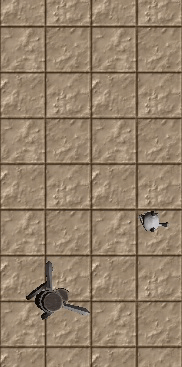Lesson 11
An Enemy Attacks!
In which we give our Walking Enemy the means to attack us
Making our “Walking Enemy” attack the player-character is fairly straightforward.
To start with, the attack itself. This will be fundamentally similar to the player’s laser-attack, but instead of using an indefinitely-long ray we will use a limited-length (in fact, quite short) line-segment, thus creating a “melee attack”.
# In your "import" statements:
from panda3d.core import CollisionSegment# In the "__init__" method of "WalkingEnemy":
self.attackSegment = CollisionSegment(0, 0, 0, 1, 0, 0)
segmentNode = CollisionNode("enemyAttackSegment")
segmentNode.addSolid(self.attackSegment)
# A mask that matches the player's, so that
# the enemy's attack will hit the player-character,
# but not the enemy-character (or other enemies)
mask = BitMask32()
mask.setBit(1)
segmentNode.setFromCollideMask(mask)
mask = BitMask32()
segmentNode.setIntoCollideMask(mask)
self.attackSegmentNodePath = render.attachNewNode(segmentNode)
self.segmentQueue = CollisionHandlerQueue()
base.cTrav.addCollider(self.attackSegmentNodePath, self.segmentQueue)
# How much damage the enemy's attack does
# That is, this results in the player-character's
# health being reduced by one.
self.attackDamage = -1The detection of hits is once again pretty much the same as in the case of the player: sort the collision-queue, take the first hit (if any), and if that hit was on a GameObject, have that object take damage.
But where the player-character has the attack be controlled by the player’s input, the Walking Enemy will control its attack via its “runLogic” method.
# In your "import" statements:
import random# In the "__init__" method of "WalkingEnemy":
# The delay between the start of an attack,
# and the attack (potentially) landing
self.attackDelay = 0.3
self.attackDelayTimer = 0
# How long to wait between attacks
self.attackWaitTimer = 0# In the "runLogic" method of "WalkingEnemy":
# Set the segment's start- and end- points.
# "getQuat" returns a quaternion--a representation
# of orientation or rotation--that represents the
# NodePath's orientation. This is useful here,
# because Panda's quaternion class has methods to get
# forward, right, and up vectors for that orientation.
# Thus, what we're doing is making the segment point "forwards".
self.attackSegment.setPointA(self.actor.getPos())
self.attackSegment.setPointB(self.actor.getPos() + self.actor.getQuat().getForward()*self.attackDistance)Previously, we had the following in the “runLogic” method of “WalkingEnemy”:
if distanceToPlayer > self.attackDistance*0.9:
self.walking = True
vectorToPlayer.setZ(0)
vectorToPlayer.normalize()
self.velocity += vectorToPlayer*self.acceleration*dt
else:
self.walking = False
self.velocity.set(0, 0, 0)We’ll now add to this a bit:
If the enemy is far from the player, and isn’t playing its attack animation, it’s allowed to move. Furthermore, it resets its attack -waiting and -delaying timers.
If it’s near to the player, it stops moving. If the attack-delay timer is active–that is, it’s attacking, and waiting for the point at which an attack “lands”–it runs that timer down. When the timer runs out, it checks the collision-queue for a hit, and if one’s detected, it applies damage. On the other hand, if the attack-wait timer is active–that is, it’s between attacks, waiting to start an attack–it runs that timer down. When the timer runs out, it starts an attack, and sets the attack-delay timer.
The result looks like this:
if distanceToPlayer > self.attackDistance*0.9:
attackControl = self.actor.getAnimControl("attack")
if not attackControl.isPlaying():
self.walking = True
vectorToPlayer.setZ(0)
vectorToPlayer.normalize()
self.velocity += vectorToPlayer*self.acceleration*dt
self.attackWaitTimer = 0.2
self.attackDelayTimer = 0
else:
self.walking = False
self.velocity.set(0, 0, 0)
# If we're waiting for an attack to land...
if self.attackDelayTimer > 0:
self.attackDelayTimer -= dt
# If the time has come for the attack to land...
if self.attackDelayTimer <= 0:
# Check for a hit..
if self.segmentQueue.getNumEntries() > 0:
self.segmentQueue.sortEntries()
segmentHit = self.segmentQueue.getEntry(0)
hitNodePath = segmentHit.getIntoNodePath()
if hitNodePath.hasPythonTag("owner"):
# Apply damage!
hitObject = hitNodePath.getPythonTag("owner")
hitObject.alterHealth(self.attackDamage)
self.attackWaitTimer = 1.0
# If we're instead waiting to be allowed to attack...
elif self.attackWaitTimer > 0:
self.attackWaitTimer -= dt
# If the wait has ended...
if self.attackWaitTimer <= 0:
# Start an attack!
# (And set the wait-timer to a random amount,
# to vary things a little bit.)
self.attackWaitTimer = random.uniform(0.5, 0.7)
self.attackDelayTimer = self.attackDelay
self.actor.play("attack")And finally, as with the player-character, there’s a bit of cleanup to do:
# In the "WalkingEnemy" class:
def cleanup(self):
base.cTrav.removeCollider(self.attackSegmentNodePath)
self.attackSegmentNodePath.removeNode()
GameObject.cleanup(self)And that’s it! If you run the game now, you should find that our WalkingEnemy not only chases the player, but attacks when in range, too!

This is all very well and good, but right now all those hits and collisions don’t have much effect. To start with, let’s add some visual feedback: beam-impacts, hit-flashes, and a bit of UI…